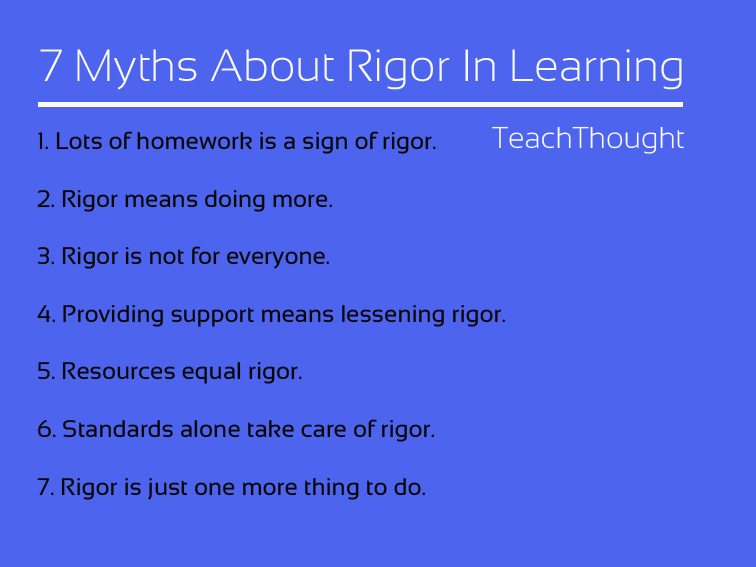Rigor In The Classroom: 7 Myths
contributed by Barbara Blackburn, author of Rigor is not a 4-Letter Word
Despite all the research, there are seven myths about rigor that are often heard. Let’s look at each, then turn our attention to the true meaning of rigor.
- Lots of homework is a sign of rigor.
- Rigor means doing more.
- Rigor is not for everyone.
- Providing support means lessening rigor.
- Resources equal rigor.
- Standards alone take care of rigor.
- Rigor is just one more thing to do.
1. Lots of homework is a sign of rigor.
For many people the best indicator of rigor is the amount of homework required of students. Some teachers pride themselves on the amount of homework expected of their students, and there are parents who judge teachers by homework quantity.
Realistically, all homework is not equally useful.Some of it is just busywork, assigned by teachers because principals or parents expect it. For some students, doing more homework in terms of quantity leads to burnout. When that occurs, students are less likely to complete homework, and may be discouraged about any learning activity.
2. Rigor means doing more.
“Doing more” often means doing more low-level activities, frequently repetitions of things already learned. Such narrow and rigid approaches to learning do not define a rigorous classroom. Students learn in many different ways. Just as instruction must vary to meet the individual needs of students, so must homework.
Rigorous and challenging learning experiences will vary with the student. Their design will vary; as will their duration. Ultimately, it is the quality of the assignment that makes a difference in terms of rigor.
3. Rigor is not for everyone.
Often, teachers think the only way to assure success for everyone is to lower standards and lessen rigor. This may mask a hidden belief that some students can’t really learn at high levels. You may have heard of the Pygmalion Effect—students live up to or down to our expectations of them.
Each student can complete rigorous work at high levels, whether they are advanced or a student with special needs. Does the end result look different for those two students? Yes, but I know from my own experience as a teacher of struggling students reading far below their grade level that any teacher can be rigorous, and any student can reach higher levels with the right support.
4. Providing support means lessening rigor.
In America, we believe in rugged individualism. We are to pull ourselves up by our bootstraps and do things on our own. Working in teams or accepting help is often seen as a sign of weakness. Supporting students so that they can learn at high levels is central to the definition of rigor. As teachers design lessons moving students toward more challenging work, they must provide scaffolding to support them as they learn.
5. Resources equal rigor.
Recently, I’ve heard a common refrain. “If we buy this program, or technology, then we would be rigorous.” The right resources can certainly help increase the rigor in your classroom. However, raising the level of rigor for your students is not dependent on the resources you have.
Think about the resources you have now. How can you use them more effectively? Do you use a textbook that includes true-false tests? Often, they are not rigorous because students can guess the answer. However, add one step for more rigor. Ask students to rewrite all false answers into true statements, and it requires students to demonstrate true understanding. It’s not the resources; it’s how you use them that make a difference.
6. Standards alone take care of rigor.
Standards alone, even if they are rigorous, do not guarantee rigor in the classroom. The Common Core State Standards are designed to increase the level of rigor in classrooms across the nation. However, if implemented with- out high levels of questioning or applications, the standards themselves are weakened. Your instructional practices, or how you implement standards, are just as critical as the curriculum.
7. Rigor is just one more thing to do.
Rigor is not another thing to add to your plate. Instead, rigor is increasing the level of expectation of what you are already doing. For example, if you are teaching vocabulary, instead of asking students to write their own definition of the word, ask them to write a riddle. It’s the same end result, but at higher levels of Bloom’s Taxonomy.
Barbara is a best-selling author of 14 books, including Rigor Is Not A Four-Letter Word.
